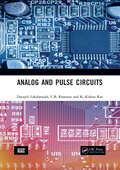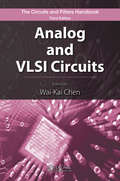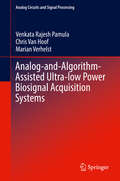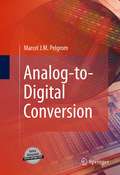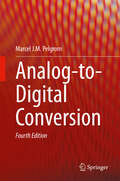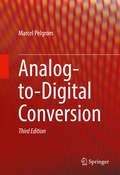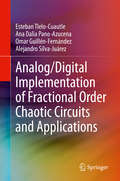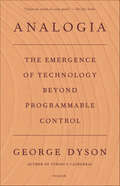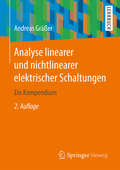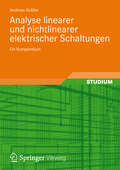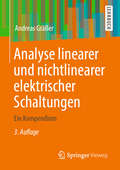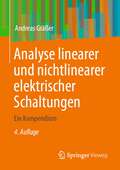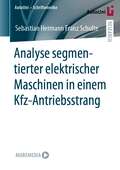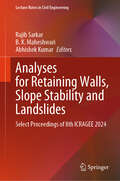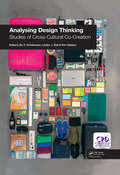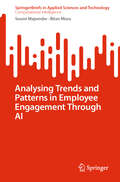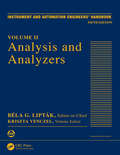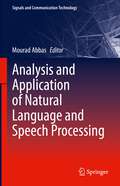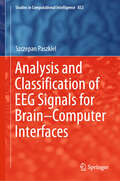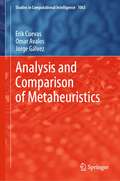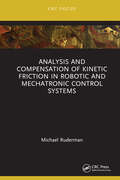- Table View
- List View
Analog and Pulse Circuits
by Dayaydi Lakshmaiah C.B. Ramarao K. Kishan RaoThis book is intended for anyone who has an interest to learn the analysis and design of analog and digital systems. The book covers the foundation of analysis and design of all analog and pulse circuits. The book is organized into seven chapters. In each chapter, practical derivations are explained step by step. Note: T& F does not sell or distribute the Hardback in India, Pakistan, Nepal, Bhutan, Bangladesh and Sri Lanka.
Analog and VLSI Circuits (The Circuits and Filters Handbook, 3rd Edition)
by Wai-Kai ChenFeaturing hundreds of illustrations and references, this volume in the third edition of the Circuits and Filters Handbook, provides the latest information on analog and VLSI circuits, omitting extensive theory and proofs in favor of numerous examples throughout each chapter. The first part of the text focuses on analog integrated circuits, presenting up-to-date knowledge on monolithic device models, analog circuit cells, high performance analog circuits, RF communication circuits, and PLL circuits. In the second half of the book, well-known contributors offer the latest findings on VLSI circuits, including digital systems, data converters, and systolic arrays.
Analog-and-Algorithm-Assisted Ultra-low Power Biosignal Acquisition Systems (Analog Circuits and Signal Processing)
by Chris Van Hoof Marian Verhelst Venkata Rajesh PamulaThis book discusses the design and implementation aspects of ultra-low power biosignal acquisition platforms that exploit analog-assisted and algorithmic approaches for power savings.The authors describe an approach referred to as “analog-and-algorithm-assisted” signal processing.This enables significant power consumption reductions by implementing low power biosignal acquisition systems, leveraging analog preprocessing and algorithmic approaches to reduce the data rate very early in the signal processing chain.They demonstrate savings for wearable sensor networks (WSN) and body area networks (BAN), in the sensors’ stimulation power consumption, as well in the power consumption of the digital signal processing and the radio link. Two specific implementations, an adaptive sampling electrocardiogram (ECG) acquisition and a compressive sampling (CS) photoplethysmogram (PPG) acquisition system, are demonstrated.First book to present the so called, “analog-and-algorithm-assisted” approaches for ultra-low power biosignal acquisition and processing platforms;Covers the recent trend of “beyond Nyquist rate” signal acquisition and processing in detail, including adaptive sampling and compressive sampling paradigms;Includes chapters on compressed domain feature extraction, as well as acquisition of photoplethysmogram, an emerging optical sensing modality, including compressive sampling based PPG readout with embedded feature extraction;Discusses emerging trends in sensor fusion for improving the signal integrity, as well as lowering the power consumption of biosignal acquisition systems.
Analog-to-Digital Conversion
by Marcel J.M. PelgromThis textbook is appropriate for use in graduate-level curricula in analog to digital conversion, as well as for practicing engineers in need of a state-of-the-art reference on data converters. It discusses various analog-to-digital conversion principles, including sampling, quantization, reference generation, nyquist architectures and sigma-delta modulation. This book presents an overview of the state-of-the-art in this field and focuses on issues of optimizing accuracy and speed, while reducing the power level. This new, second edition emphasizes novel calibration concepts, the specific requirements of new systems, the consequences of 22-nm technology and the need for a more statistical approach to accuracy. Pedagogical enhancements to this edition include more than twice the exercises available in the first edition, solved examples to introduce all key, new concepts and warnings, remarks and hints, from a practitioner's perspective, wherever appropriate. Considerable background information and practical tips, from designing a PCB, to lay-out aspects, to trade-offs on system level, complement the discussion of basic principles, making this book a valuable reference for the experienced engineer.
Analog-to-Digital Conversion
by Marcel J.M. PelgromThis textbook is appropriate for use in graduate-level curricula in analog-to-digital conversion, as well as for practicing engineers in need of a state-of-the-art reference on data converters. It discusses various analog-to-digital conversion principles, including sampling, quantization, reference generation, Nyquist architectures and sigma-delta modulation. This book presents an overview of the state-of-the-art in this field and focuses on issues of optimizing accuracy and speed, while reducing the power level. This new, fourth edition emphasizes novel calibration concepts, the specific requirements of systems, the consequences of advanced technology and the need for a more statistical approach to accuracy. Pedagogical enhancements to this edition include additional, new exercises, solved examples to introduce all key, new concepts and warnings, remarks and hints, from a practitioner's perspective, wherever appropriate. Considerable background information and practical tips, from designing a PCB, to lay-out aspects, to trade-offs on system level, complement the discussion of basic principles, making this book a valuable reference for the experienced engineer.
Analog-to-Digital Conversion
by Marcel PelgromA book is like a window that allows you to look into the world. The window is shaped by the author and that makes that every window presents a unique view of the world. This is certainly true for this book. It is shaped by the topics and the projects throughout my career. Even more so, this book re'ects my own style of working and thinking. That starts already in Chap. 2. When I joined Philips Research in 1979, many of my colleagues used little paper notebooks to keep track of the most used equations and other practical things. This notebook was the beginning for Chap. 2: a collection of topics that form the basis for much of the other chapters. Chapter2 is not intended to explain these topics, but to refresh your knowledge and help you when you need some basics to solve more complex issues. In the chapters discussing the fundamental processes of conversion, you will r- ognize my preoccupation with mathematics. I really enjoy ?nding an equation that properly describes the underlying mechanism. Nevertheless mathematics is not a goalonitsown:theequationshelptounderstandthewaythevariablesareconnected to the result. Real insight comes from understanding the physics and electronics. In the chapters on circuit design I have tried to reduce the circuit diagrams to the s- plest form, but not simpler. . . I do have private opinions on what works and what should not be applied.
Analog/Digital Implementation of Fractional Order Chaotic Circuits and Applications
by Esteban Tlelo-Cuautle Ana Dalia Pano-Azucena Omar Guillén-Fernández Alejandro Silva-JuárezThis book details the simulation and optimization of integer and fractional-order chaotic systems, and how they can be implemented in the analog and digital domains using FPAAs and FPGAs. Design guidelines are provided to use commercially available electronic devices, and to perform hardware descriptions of integer/fractional-order chaotic systems programming in VHDL. Finally, several engineering applications oriented to cryptography, internet of things, robotics and chaotic communications, are detailed to highlight the usefulness of FPAA/FPGA based integer/fractional-order chaotic systems.Provides guidelines to implement fractional-order derivatives using commercially available devices;Describes details on using FPAAs to approach fractional-order chaotic systems;Includes details on using FPGAs to approach fractional-order chaotic systems, programming in VHDL and reducing hardware resources;Discusses applications to cryptography, internet of things, robotics and chaotic communications.
Analogia: The Emergence of Technology Beyond Programmable Control
by George DysonNamed one of WIRED’s "The Best Pop Culture That Got Us Through 2020"In Analogia, technology historian George Dyson presents a startling look back at the analog age and life before the digital revolution—and an unsettling vision of what comes next.In 1716, the philosopher and mathematician Gottfried Wilhelm Leibniz spent eight days taking the cure with Peter the Great at Bad Pyrmont in Saxony, trying to persuade the tsar to launch a voyage of discovery from Russia to America and to adopt digital computing as the foundation for a remaking of life on earth. In two classic books, Darwin Among the Machines and Turing’s Cathedral, George Dyson chronicled the realization of the second of Leibniz’s visions. In Analogia, his pathbreaking new book, he brings the story full circle, starting with the Russian American expedition of 1741 and ending with the beyond-digital revolution that will completethe transformation of the world.Dyson enlists a startling cast of characters, from the time of Catherine the Great to the age of machine intelligence, and draws heavily on his own experiences at the Institute for Advanced Study in Princeton, New Jersey, and onward to the rain forest of the Northwest Coast. We are, Dyson reveals, entering a new epoch in human history, one driven by a generation of machines whose powers are no longer under programmable control. Includes black-and-white illustrations
Analyse linearer und nichtlinearer elektrischer Schaltungen: Ein Kompendium
by Andreas GräßerEin Kompendium, das die in der Elektrotechnik, Mechatronik usw. #65533;blichen Schaltungs-Analyseverfahren sehr #65533;bersichtlich nebeneinanderstellt und erl#65533;utert. Dabei werden ,,Verwandtschaften" und Einsatzgebiete der verschiedenen Verfahren deutlich herausgestellt und abgegrenzt. Dar#65533;ber hinaus werden auch numerische Verfahren ber#65533;cksichtigt und es wird dargestellt, wie Schaltungssimulatoren funktionieren. An Hand einer kostenlos aus dem Internet zu beziehenden Demoversion des Schaltungssimulators PSpice wird dem Leser auch praktisches "Simulations-Know-How" vermittelt. Das Buch ist besonders f#65533;r Studierende in Bachelorstudieng#65533;ngen geeignet.
Analyse linearer und nichtlinearer elektrischer Schaltungen: Ein Kompendium
by Andreas GräßerEin Kompendium, das die in der Elektrotechnik, Mechatronik usw. üblichen Schaltungs-Analyseverfahren sehr übersichtlich nebeneinanderstellt und erläutert. Dabei werden "Verwandtschaften" und Einsatzgebiete der verschiedenen Verfahren deutlich herausgestellt und abgegrenzt. Darüber hinaus werden auch numerische Verfahren berücksichtigt und es wird dargestellt, wie Schaltungssimulatoren funktionieren. An Hand einer kostenlos aus dem Internet zu beziehenden Demoversion des Schaltungssimulators PSpice wird dem Leser auch praktisches "Simulations-Know-How" vermittelt. Das Buch ist besonders für Studierende in Bachelorstudiengängen geeignet.
Analyse linearer und nichtlinearer elektrischer Schaltungen: Ein Kompendium
by Andreas GräßerEin Kompendium, das die in der Elektrotechnik, Mechatronik usw. üblichen Schaltungs-Analyseverfahren sehr übersichtlich nebeneinander stellt und erläutert. Dabei werden „Verwandtschaften“ und Einsatzgebiete der verschiedenen Verfahren deutlich herausgestellt und abgegrenzt. Darüber hinaus werden auch numerische Verfahren berücksichtigt und es wird dargestellt, wie Schaltungssimulatoren funktionieren. An Hand einer kostenlos aus dem Internet zu beziehenden Demoversion des Schaltungssimulators PSpice wird dem Leser auch praktisches "Simulations-Know-How" vermittelt. Das Buch ist besonders für Studierende in Bachelorstudiengängen geeignet.
Analyse linearer und nichtlinearer elektrischer Schaltungen: Ein Kompendium
by Andreas GräßerEin Kompendium, das die in der Elektrotechnik, Mechatronik usw. üblichen Schaltungs-Analyseverfahren sehr übersichtlich nebeneinander stellt und erläutert. Dabei werden „Verwandtschaften“ und Einsatzgebiete der verschiedenen Verfahren deutlich herausgestellt und abgegrenzt. Darüber hinaus werden auch numerische Verfahren berücksichtigt und es wird dargestellt, wie Schaltungssimulatoren funktionieren. An Hand einer kostenlos aus dem Internet zu beziehenden Demoversion des Schaltungssimulators LTspice wird dem Leser auch praktisches "Simulations-Know-How" vermittelt. Das Buch ist besonders für Studierende in Bachelorstudiengängen geeignet.
Analyse segmentierter elektrischer Maschinen in einem Kfz-Antriebsstrang (AutoUni – Schriftenreihe #160)
by Sebastian Hermann SchulteZur Integration elektrischer Antriebe in einem Kfz-Antriebsstrang mit spezifischem Bauraum werden in der vorliegenden Arbeit segmentierte elektrische Maschinen untersucht. Segmentierte elektrische Maschinen zeichnen sich dadurch aus, dass der Rotor nicht vollständig vom Stator überdeckt ist und so nicht zylindrische Bauräume besser ausgenutzt werden können. Nach einer analytischen Analyse werden getroffene Annahmen mittels FEM-Berechnungen überprüft, erkannte Effekte an den Segmentgrenzen genauer betrachtet und die berechneten Ergebnisse abschließend messtechnisch validiert.
Analyses for Retaining walls, Slope Stability and Landslides: Select Proceedings of 8th ICRAGEE 2024 (Lecture Notes in Civil Engineering #568)
by Abhishek Kumar Rajib Sarkar B. K. MaheshwariThis book will present the select proceedings of the 8th International Conference on Recent Advances in Geotechnical Earthquake Engineering and Soil Dynamics (8ICRAGEE) held at the Indian Institute of Technology (IIT), Guwahati between December 11 and 14, 2024. It contains the latest research papers covering the contributions and accomplishments in geotechnical earthquake engineering and soil dynamics in the last four years. The five volumes of the book cover a wide range of topics, including but not limited to seismic hazard analysis, wave propagation and site characterization, dynamic properties and liquefaction of soils, pile foundations, offshore foundations, seismic design of retaining structures and dams, seismic slope stability and landslides, dynamic soil-structure interaction, seismic design of structures. Further, recent developments on these topics are covered in different chapters. This book will be valuable not only for researchers and professionals but also for drawing an agenda for future courses of action from the perspective of geotechnical earthquake engineering, keeping the national need at the forefront.
Analysing Design Thinking: Studies of Cross-Cultural Co-Creation
by Kim Halskov Bo Christensen Linden BallThe scientific analysis of design thinking continues to burgeon and is of considerable interest to academic scholars and design practitioners across many disciplines. This research tradition has generated a growing corpus of studies concerning how designers think during the creation of innovative products, although less focus has been given to analysing how designers think when creating less tangible deliverables such as concepts and user-insights. Analysing Design Thinking: Studies of Cross-Cultural Co-Creation brings together 28 contributions from internationally-leading academics with a shared interest in design thinking who take a close look at professional designers working on a project that not only involves soft deliverables, but where a central role is played by co-creation across multiple, culturally diverse stakeholders. This collection of detailed, multi-method analyses gives a unique insight into how a Scandinavian design team tackled a specific design task within the automotive industry over a four-month design process. All papers draw upon a common, video-based dataset and report analyses that link together a diversity of academic disciplines including psychology, anthropology, linguistics, philosophy, architecture, management, engineering and design studies. The dataset affords multiple entry points into the analysis of design thinking, with the selected papers demonstrating the application of a wide range of analytic techniques that generate distinct yet complementary insights. Collectively these papers provide a coherent framework for analysing and interpreting design thinking ‘in vivo’ through video-based field studies.
Analysing Trends and Patterns in Employee Engagement Through AI (SpringerBriefs in Applied Sciences and Technology)
by Soumi Majumder Bitan MisraThis book explores the concept of employee engagement, which is crucial for a company's success, as it is closely linked to job satisfaction and employee morale. Engaged workers tend to be more productive, efficient, and committed to the values and objectives of the company. Artificial intelligence plays a significant role in HR analytics, particularly in automating tedious tasks like data collection and organization from multiple sources. AI-driven employee engagement software can analyze employee feedback, surveys, and social media posts to capture the overall sentiment of the workforce. This allows HR teams to gain insights into employee experiences and perceptions, uncover areas for improvement, and address any issues that require attention. By leveraging past data and employing machine learning algorithms, AI enables HR professionals to predict turnover rates, forecast employee engagement levels, and identify potential flight risks.
Analysing Users' Interactions with Khan Academy Repositories
by Seifedine Kadry Sahar Yassine Miguel-Ángel SiciliaThis book addresses the need to explore user interaction with online learning repositories and the detection of emergent communities of users. This is done through investigating and mining the Khan Academy repository; a free, open access, popular online learning repository addressing a wide content scope. It includes large numbers of different learning objects such as instructional videos, articles, and exercises. The authors conducted descriptive analysis to investigate the learning repository and its core features such as growth rate, popularity, and geographical distribution. The authors then analyzed this graph and explored the social network structure, studied two different community detection algorithms to identify the learning interactions communities emerged in Khan Academy then compared between their effectiveness. They then applied different SNA measures including modularity, density, clustering coefficients and different centrality measures to assess the users’ behavior patterns and their presence.By applying community detection techniques and social network analysis, the authors managed to identify learning communities in Khan Academy’s network. The size distribution of those communities found to follow the power-law distribution which is the case of many real-world networks.Despite the popularity of online learning repositories and their wide use, the structure of the emerged learning communities and their social networks remain largely unexplored. This book could be considered initial insights that may help researchers and educators in better understanding online learning repositories, the learning process inside those repositories, and learner behavior.
Analysing Web Traffic: A Case Study on Artificial and Genuine Advertisement-Related Behaviour (Studies in Big Data #127)
by Sławomir Zadrożny Jan W. Owsiński Olgierd Hryniewicz Karol Opara Agnieszka Jastrzębska Marek Gajewski Mariusz Kozakiewicz Tomasz ZwierzchowskiThis book presents ample, richly illustrated account on results and experience from a project, dealing with the analysis of data concerning behavior patterns on the Web. The advertising on the Web is dealt with, and the ultimate issue is to assess the share of the artificial, automated activity (ads fraud), as opposed to the genuine human activity.After a comprehensive introductory part, a full-fledged report is provided from a wide range of analytic and design efforts, oriented at: the representation of the Web behavior patterns, formation and selection of telling variables, structuring of the populations of behavior patterns, including the use of clustering, classification of these patterns, and devising most effective and efficient techniques to separate the artificial from the genuine traffic.A series of important and useful conclusions is drawn, concerning both the nature of the observed phenomenon, and hence the characteristics of the respective datasets, and the appropriateness of the methodological approaches tried out and devised. Some of these observations and conclusions, both related to data and to methods employed, provide a new insight and are sometimes surprising. The book provides also a rich bibliography on the main problem approached and on the various methodologies tried out.
Analysis and Analyzers: Volume II
by Béla G. LiptákThe Instrument and Automation Engineers’ Handbook (IAEH) is the #1 process automation handbook in the world. Volume two of the Fifth Edition, Analysis and Analyzers, describes the measurement of such analytical properties as composition. Analysis and Analyzers is an invaluable resource that describes the availability, features, capabilities, and selection of analyzers used for determining the quality and compositions of liquid, gas, and solid products in many processing industries. It is the first time that a separate volume is devoted to analyzers in the IAEH. This is because, by converting the handbook into an international one, the coverage of analyzers has almost doubled since the last edition. Analysis and Analyzers: Discusses the advantages and disadvantages of various process analyzer designs Offers application- and method-specific guidance for choosing the best analyzer Provides tables of analyzer capabilities and other practical information at a glance Contains detailed descriptions of domestic and overseas products, their features, capabilities, and suppliers, including suppliers’ web addresses Complete with 82 alphabetized chapters and a thorough index for quick access to specific information, Analysis and Analyzers is a must-have reference for instrument and automation engineers working in the chemical, oil/gas, pharmaceutical, pollution, energy, plastics, paper, wastewater, food, etc. industries. About the eBookThe most important new feature of the IAEH, Fifth Edition is its availability as an eBook. The eBook provides the same content as the print edition, with the addition of thousands of web addresses so that readers can reach suppliers or reference books and articles on the hundreds of topics covered in the handbook. This feature includes a complete bidders' list that allows readers to issue their specifications for competitive bids from any or all potential product suppliers.
Analysis and Application of Analog Electronic Circuits to Biomedical Instrumentation (Biomedical Engineering Ser.)
by Robert B. NorthropAnalysis and Application of Analog Electronic Circuits to Biomedical Instrumentation, Second Edition helps biomedical engineers understand the basic analog electronic circuits used for signal conditioning in biomedical instruments. It explains the function and design of signal conditioning systems using analog ICs-the circuits that enable ECG, EEG,
Analysis and Application of Natural Language and Speech Processing (Signals and Communication Technology)
by Mourad AbbasThis book presents recent advances in NLP and speech technology, a topic attracting increasing interest in a variety of fields through its myriad applications, such as the demand for speech guided touchless technology during the Covid-19 pandemic. The authors present results of recent experimental research that provides contributions and solutions to different issues related to speech technology and speech in industry. Technologies include natural language processing, automatic speech recognition (for under-resourced dialects) and speech synthesis that are useful for applications such as intelligent virtual assistants, among others. Applications cover areas such as sentiment analysis and opinion mining, Arabic named entity recognition, and language modelling. This book is relevant for anyone interested in the latest in language and speech technology.
Analysis and Classification of EEG Signals for Brain–Computer Interfaces (Studies in Computational Intelligence #852)
by Szczepan PaszkielThis book addresses the problem of EEG signal analysis and the need to classify it for practical use in many sample implementations of brain–computer interfaces. In addition, it offers a wealth of information, ranging from the description of data acquisition methods in the field of human brain work, to the use of Moore–Penrose pseudo inversion to reconstruct the EEG signal and the LORETA method to locate sources of EEG signal generation for the needs of BCI technology. In turn, the book explores the use of neural networks for the classification of changes in the EEG signal based on facial expressions. Further topics touch on machine learning, deep learning, and neural networks. The book also includes dedicated implementation chapters on the use of brain–computer technology in the field of mobile robot control based on Python and the LabVIEW environment. In closing, it discusses the problem of the correlation between brain–computer technology and virtual reality technology.
Analysis and Comparison of Metaheuristics (Studies in Computational Intelligence #1063)
by Erik Cuevas Jorge Gálvez Omar AvalosThis book presents a comparative perspective of current metaheuristic developments, which have proved to be effective in their application to several complex problems. The study of biological and social entities such as animals, humans, or insects that manifest a cooperative behavior has produced several computational models in metaheuristic methods. Although these schemes emulate very different processes or systems, the rules used to model individual behavior are very similar. Under such conditions, it is not clear to identify which are the advantages or disadvantages of each metaheuristic technique. The book is compiled from a teaching perspective. For this reason, the book is primarily intended for undergraduate and postgraduate students of Science, Electrical Engineering, or Computational Mathematics. It is appropriate for courses such as Artificial Intelligence, Electrical Engineering, Evolutionary Computation. The book is also useful for researchers from the evolutionary and engineering communities. Likewise, engineer practitioners, who are not familiar with metaheuristic computation concepts, will appreciate that the techniques discussed are beyond simple theoretical tools since they have been adapted to solve significant problems that commonly arise in engineering areas.
Analysis and Compensation of Kinetic Friction in Robotic and Mechatronic Control Systems
by Michael RudermanAnalysis and Compensation of Kinetic Friction in Robotic and Mechatronic Control Systems comprehensively covers kinetic friction in a robotics, mechatronics, and control engineering context. Providing the theory behind kinetic friction, as well as compensation methods and practical solutions, the text is a key companion to studying different control systems. Beginning with a clear introduction to the subject, the book goes on to include three main facets of kinetic friction, starting with phenomena of kinetic friction in drives. This chapter explains friction interfaces and friction effects. Following from this, the next chapter looks at motion dynamics with friction, which introduces dynamic system equations and focuses on both energy balance and dissipation. Finally, the book looks at compensation of friction in motion control, which summarises key compensation methods in controlled mechanical systems. Introducing various basic feedback control methods, including observer-based methods to compensate for kinetic friction, the text provides practical information that can be used in a wide variety of contexts not specific to particular systems or applications. This book will be of interest to students and industry workers in the field of robotics, mechanical systems and control engineering.
Analysis and Control of Boolean Networks: A Semi-tensor Product Approach (Communications and Control Engineering)
by Hongsheng Qi Daizhan Cheng Zhiqiang LiAnalysis and Control of Boolean Networks presents a systematic new approach to the investigation of Boolean control networks. The fundamental tool in this approach is a novel matrix product called the semi-tensor product (STP). Using the STP, a logical function can be expressed as a conventional discrete-time linear system. In the light of this linear expression, certain major issues concerning Boolean network topology - fixed points, cycles, transient times and basins of attractors - can be easily revealed by a set of formulae. This framework renders the state-space approach to dynamic control systems applicable to Boolean control networks. The bilinear-systemic representation of a Boolean control network makes it possible to investigate basic control problems including controllability, observability, stabilization, disturbance decoupling etc.
